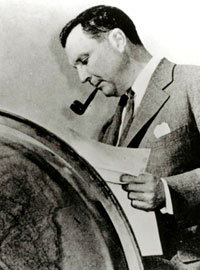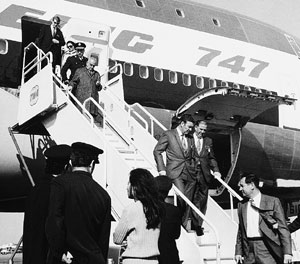
Part Three: The Birth of the 747
Starting on the ground floor at Boeing, Sutter actually had a glorious opportunity. The jet engine had been recently invented, and another technological innovation—the swept wing—was new. "I learned a lot in a hurry because I was involved in many projects and had little supervision," Sutter says. "It was a time when an engineer could work on eight planes a year. Nowadays, you are lucky if you can work on one or two."
He was the aerodynamics unit chief on the Boeing Model 367-80 (forerunner of the 707) and later the chief of technology on the 727. That set the stage for his big break in 1965—a landmark time to be in the airplane business. Air travel had boomed. The number of international passengers had climbed from 7.5 million in the mid-1950s to more than 35 million in 1965 and was predicted to surpass 100 million by 1980.

Juan Trippe in an early publicity still from Pan Am.
At the time, the Pentagon wanted a huge new cargo plane (the C-5A)—and it made sense that a commercial version would follow. While Boeing lost the C-5A contract to Lockheed, it nonetheless entered into the competition to build a huge passenger plane at the urging of Juan Trippe, head of Pan Am, one of the industry's most influential power brokers. The story that has made the rounds is that Sutter, then vacationing at a remote cabin near Hood Canal in August, was tracked down by Boeing president Bill Allen and given the assignment. Actually, it was a Boeing vice president (Dick Rouzie) who reached him.
At first, Sutter headed up a small study group to see if building a plane that big was feasible. After some time, one of Sutter's superiors came out of a meeting and approached the designer, who was working off napkin doodles and sketches. "Well, Sutter, you've got your hands full now. The boss just committed that you could build this airplane. Good luck."
Sutter and his team (called "Sutter's Runaways") were off to the races. But this was no ordinary big, fun design challenge—besides having the burden of coming up with a new plane, and beating competitors to the punch, Boeing was funding the multi-million dollar project entirely with its own money. To put it bluntly, the company's entire future was banking on Sutter.
Sutter and his design team proposed three versions, with 250, 300 and 350 seats. Pan Am and other interested airlines went for the largest version, which was going to be 2 1/2 times the size of the 707 and require four of the largest airplane engines ever made. Nothing this large had ever been attempted.
A double-decker model favored by some was quickly dismissed as an engineering nightmare. Sutter then came up with the idea of twin aisles, with three rows across of seats. The wide body jet was born. "I got a feeling it looked right," he says.
But Sutter's real stroke of genius was in providing the ability to carry 8 foot by 8 foot containers side by side on the main deck. By anticipating that the air freight industry would eventually adopt uniform-sized shipping containers, Sutter designed the 747 cross section to accommodate a large number of containers, stacked side by side. Thus, the 747 not only captured the passenger market but the lucrative freight market.
Partway through the design phase, it was clear Boeing faced another major hurdle: it didn't have a plant large enough to build the 747. So it embarked on the mammoth task of clearing a forest next to Paine Field in Everett to create the world's largest building to make the 747.

Joe Sutter (at bottom right) was part of a mid-1970s Boeing delegation visiting Greece and other Middle Eastern countries interested in a closer look at the 747. Photo courtesy Joe Sutter.
On Sept. 30, 1968—a mere 28 months after Sutter (who went from design chief to being in total control of the 747 project) first doodled out a sketch—the first 747 was rolled out of its hangar. Few had seen anything like it. Boeing proudly said you could play basketball on the wing of a 747 and that the tail was six stories tall. Everyone who gathered in Everett cheered in awe. But there were skeptics, both inside and outside of Boeing, who didn't think a plane that big could fly. Some of Sutter's friends even asked his wife if he knew what he was doing.
"Flying it was never a concern of mine," Sutter says now. "The real concern was landing something this large. That was the challenge." But it turned out to be no problem.
The first 747 flight with paying passengers occurred on Jan. 21, 1970. Pan Am's Clipper Constitution was bound from New York to London. "The 747 will make it possible for more and more people to discover what their neighbors are like on the other side of the world," the New York Times crowed. After an unanticipated delay, the first commercial 747 took off on its maiden flight and changed commercial flight forever.
Go To: Page 1 | Page 2 | Page 3
- Return to June 2001 Table of Contents